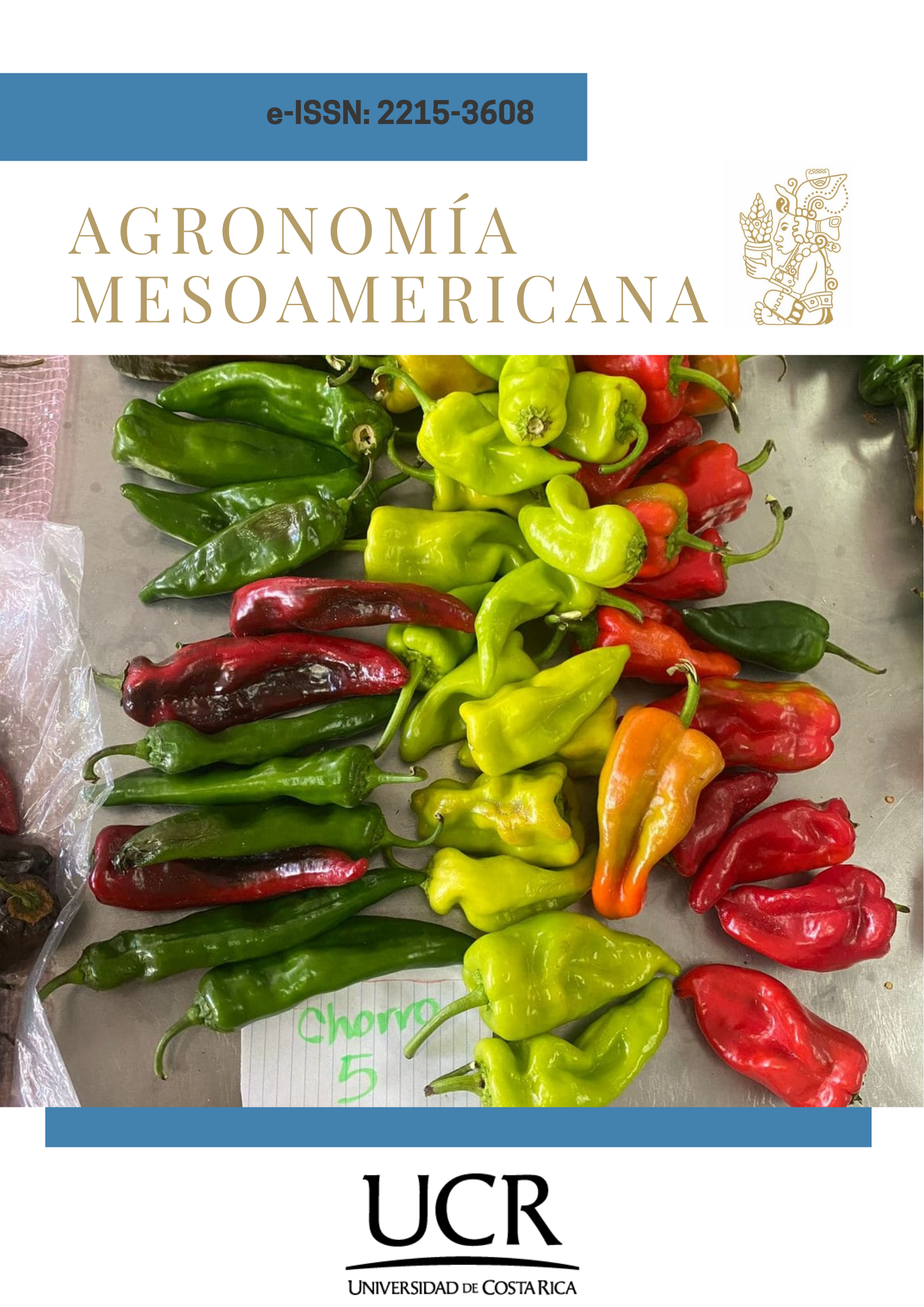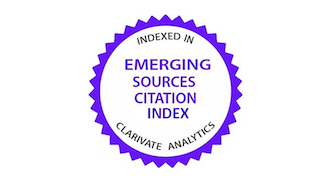Morphological characterization of advanced pepper lines (Capsicum annuum L.) from central Mexico
DOI:
https://doi.org/10.15517/am.2025.61651Keywords:
Genetic diversity, plant morphology, biological trait, plant breedingAbstract
Introduction. Of the five cultivated pepper species, Capsicum annuum L. is the most important worldwide, due to its high demand in the food, medical, and cosmetic industries, among others. Mexico has the greatest diversity of cultivated types, including jalapeño, guajillo, ancho, serrano, and habanero. However, some farmers grow native materials that should be studied and preserved, such as mulato and chilaca. In certain cases, like chilaca, there are no improved commercial cultivars, so producers depend on the seed they produce. Objective. To morphologically characterize advanced lines of different C. annuum types from central Mexico. Materials and methods. The study was conducted during the spring-summer cycles of 2022 and 2023, at the Bajío Experimental Station, located in Celaya, Guanajuato, Mexico. In 32 advanced lines of eight C. annuum types, 42 traits were evaluated based on the guidelines of the International Union for the Protection of New Varieties of Plants and the International Plant Genetic Resources Institute guide. The data obtained were analyzed using descriptive statistics and subjected to cluster and correspondence analysis. Results. Morphological variation showed that fifteen plant, leaf, and fruit traits were crucial to differentiating pepper types and lines. Based on similar traits, the cluster analysis grouped them into five clusters. Groups I and III included three pepper types, and six traits presented the highest positive eigenvectors. Conclusions. The observed diversity revealed determinant morphological characteristics to distinguish pepper types and lines, which must complete their genetic improvement process.
Downloads
References
Aguilar-Meléndez, A., Morrell, P. L., Roose, M. L., & Seung-Chul, K. (2009). Genetic diversity and structure in semiwild and domesticated chiles (Capsicum annuum; Solanaceae) from Mexico. American Journal of Botany, 96(6), 1190–1202. https://doi.org/10.3732/ajb.0800155
Aguilar-Rincón, V. H., Corona-Torres, T., López-López, P., Latournerie-Moreno, L., Ramírez-Meraz, M., Villalón-Mendoza, H., & Aguilar-Castillo, J. A. (2010). Los chiles de México y su distribución (1.ª ed.). Sistema Nacional de Recursos Fitogenéticos para la Alimentación y la Agricultura.
Alcalá-Rico, J. S. G., Ramírez-Meraz, M., Maldonado-Moreno, N., Borja-Bravo, M., Camposeco-Montejo, N., & López-Benítez, A. (2023). Morphological variation in fruits of piquín pepper genotypes (Capsicum annuum var. glabriusculum) from Northeast and Central Mexico. Ecosistemas y Recursos Agropecuarios, 10(2), 1–13. https://doi.org/10.19136/era.a10n2.3482
Bozokalfa, M. K., Eşiyok, D., & Turhan, K. (2009). Patterns of phenotypic variation in a germplasm collection of pepper (Capsicum annuum L.) from Turkey. Spanish Journal of Agricultural Research, 7(1), 83–95. https://doi.org/10.5424/sjar/2009071-401
Castellón Martínez, E., Carrillo-Rodríguez, J. C., Chávez-Servia, J. L., & Vera-Guzmán, A. M. (2014). Phenotype variation of chile morphotypes (Capsicum annuum L.) native to Oaxaca, Mexico. Phyton, International Journal of Experimental Botany, 83, 226–236. https://doi.org/10.32604/phyton.2014.83.225
Cuarán Cuarán, D. A. del P., Jiménez Cardona, J. R., Rojas Pantoja, R. D., Vélez Lozano, J. A., Vallejo Cabrera, F. A., & Caetano, C. M. (2022). Caracterización morfológica y proximal de introducciones de Capsicum chinense Jaqc. (Solanaceae) para uso en programas de mejoramiento genético. Magna Scientia UCEVA, 2(1), 121–132. https://doi.org/10.54502/msuceva.v2n1a12
Escalera-Ordaz, A. K., Guillén-Andrade, H., Lara-Chávez, M. B. N., Lemus-Flores, C., Rodríguez-Carpena, J. G., & Valdivia-Bernal, R. (2019). Caracterización de variedades cultivadas de Capsicum pubescens en Michoacán, México. Revista Mexicana de Ciencias Agrícolas, 23, 239–251. https://doi.org/10.29312/remexca.v0i23.2024
García, E. (2004). Modificaciones al sistema de clasificación climática de Koppen (5.th ed., Vol. 6). Instituto Nacional de Geografía.
Hernández-Verdugo, S., Dávila-Aranda, P., & Oyama, K. (1999). Síntesis del conocimiento taxonómico, origen y domesticación del género Capsicum. Boletín de la Sociedad Botánica de México, 64, 65-84.
Instituto Internacional de Recursos Fitogenéticos. (1995). Descriptores para Capsicum (Capsicum spp.). https://pdf.usaid.gov/pdf_docs/Pnacl679.pdf
Kraft, K. H., Brown, C. H., Nabhan, G. P., Luedeling, E., Luna Ruiz, J. L., D’Eeckenbrugge, G. C., Hijmans, R. J., & Gepts, P. (2014). Multiple lines of evidence for the origin of domesticated chili pepper, Capsicum annuum, in Mexico. Proceedings of the National Academy of Sciences of the United States of America, 111(17), 6165–6170. https://doi.org/10.1073/pnas.1308933111
López, L. P. S., & Castro, G. F. H. (1999). Al rescate de la diversidad del chile (Capsicum spp) en Oaxaca (Publicación especial). Campo Experimental Valles Centrales de Oaxaca.
López-Espinosa, S. T., Latournerie-Moreno, L., Castañón-Nájera, G., Ruiz-Sánchez, E., Gómez-Leyva, J. F., Andueza-Noh, R. H., & Mijangos-Cortés, J. O. (2018). Diversidad genética de chile habanero (Capsicum chinense Jacq.) mediante ISSR. Revista Fitotecnia Mexicana, 41(3), 227-236. https://doi.org/10.35196/rfm.2018.3.227-236
Luna García, L. R., Robledo Torres, V., Ramírez Godina, F., Mendoza Villarreal, R., & Pérez Rodríguez, M. Á. (2021). Selection of F3 populations of Capsicum annuum for greenhouse production. Australian Journal of Crop Science, 15(3), 438–444. https://doi.org/10.21475/ajcs.21.15.03.p3046
Luna-Ruiz, J. J., Nabhan, G. P., & Aguilar-Meléndez, A. (2018). Shifts in plant chemical defenses of chile pepper (Capsicum annuum L.) due to domestication in Mesoamerica. Frontiers in Ecology and Evolution, 6, Article 48. https://doi.org/10.3389/fevo.2018.00048
Moreno-Pérez, E. del C., Avendaño-Arrazate, C. H., Mora-Aguilar, R., Cadena-Iñiguez, J., Aguilar-Rincón, V. H., & Aguirre-Medina, J. F. (2011). Diversidad morfológica en colectas de chile guajillo (Capsicum annuum L.) del centro-norte de México. Revista Chapingo Serie Horticultura, 17(1), 23–30.
Núñez-Colín, C. A., & Escobedo-López, D. (2011). Uso correcto del análisis clúster en la caracterización de germoplasma vegetal. Agronomía Mesoamericana, 22(2), 415–427. https://doi.org/10.15517/am.v22i2.8746
Núñez-Colín, C. A., Rodríguez-Pérez, J. E., Nieto-Ángel, R., & Barrientos-Priego, A. F. (2004). Construcción de dendrogramas de taxonomía numérica mediante el coeficiente de distancia χ2: una revisión. Revista Chapingo Serie Horticultura, 10(2), 229-237. https://doi.org/10.5154/r.rchsh.2003.07.046
Organización de las Naciones Unidas para la Alimentación y la Agricultura. (2024). Cultivos y productos de ganadería. https://www.fao.org/faostat/es/#data/QCL
Organización Internacional de Normalización. (1993). ISO 7543-1. Determinación del contenido de capsaicinoides totales-Método HPLC. Secretaría de Economía.
Pathirana, R. (2013). Peppers: vegetable and spice capsicums, 2nd edition, by Paul W. Bosland and Eric J. Votava. New Zealand Journal of Crop and Horticultural Science, 41(2), 102–103. https://doi.org/10.1080/01140671.2012.745161
Peña-Caballero, V., Morales-Vargas, A. T., & Núñez-Colín, C. A. (2020). Eigenanálisis aplicado a diferentes áreas de las ciencias agrícolas y biotecnología: una revisión. Acta Agrícola y Pecuaria, 6, Artículo e0061009. https://doi.org/10.30973/aap/2020.6.0061009
Pérez, G. M., González, H. V. A., Mendoza, C. M. C., & Peña, V. C. (2004). Physiological characterization of manzano hot pepper (Capsicum pubences R & P) landraces. Journal American Society Horticultural Science, 129(1), 88–92.
Ramírez García, A. R. (2021). Caracterización morfológica in situ de chiles (Capsicum spp.) silvestres y cultivados en la región Usumacinta, Tabasco. Kuxulkab’, 27(58), 49–57. https://doi.org/10.19136/kuxulkab.a27n58.3959
Raven, P. H., Vuelque, R. F., & Eichhorn, S. E. (2005). Biología de plantas (7.ª ed.) Book News, Inc.
Rivera, A., Monteagudo, A. B., Igartua, E., Taboada, A., García-Ulloa, A., Pomar, F., Riveiro-Leira, M., & Silvar, C. (2016). Assessing genetic and phenotypic diversity in pepper (Capsicum annuum L.) landraces from North-West Spain. Scientia Horticulturae, 203, 1–11. https://doi.org/10.1016/j.scienta.2016.03.006
Rohlf, F. J. (2009). NTSYS-pc: Numerical taxonomy and multivariate analysis system (Vol. 2, 2nd ed., Vol. 2). Applied Biostatistics, Inc.
Santiago-Luna, E. G., Carrillo-Rodríguez, J. C., Chávez-Servía, J. L., Perales-Segovia, C., & Heredia-García, E. (2018). Variation of plant and fruit traits in native Mexican costeño pepper. Horticultura Brasileira, 36(3), 399–407. https://doi.org/10.1590/s0102-053620180319
Sauceda-Acosta, C. P., González-Hernández, V. A., Sánchez-Soto, B. H., Sauceda-Acosta, R. H., Ramírez-Tobías, H. M., & Quintana-Quiroz, J. G. (2017). MACF-IJ, método automatizado para medir color y área foliar mediante imágenes digitales. Agrociencia, 51(4), 409–423.
Segovia Lerma, A., & Romero Mozqueda, Á. Y. (2014). Mejoramiento genético para rendimiento en chile (Capsicum annum L) para consumo en seco en la región centro-sur del estado Chihuahua, México. Revista Biológico Agropecuaria Tuxpan, 2(1), 320–333. https://doi.org/10.47808/revistabioagro.v2i1.312
Servicio de Información Agroalimentaria y Pesquera. (2023). Anuario estadístico de la producción agrícola. https://nube.siap.gob.mx/cierreagricola/
Singh, P., Jain, P. K., & Tiwari, A. (2020). Principal Component Analysis Approach for Yield Attributing Traits in Chilli (Capsicum annum L.) Genotypes. Chemical Science Review Letters, 9(33), 87–91. https://doi.org/10.37273/chesci.cs232050121
Tapia, C. E., Gutiérrez, E. M. A., Warburton, M. L., Santacruz, V. A., & Villegas, M. A. (2005). Characterization of mandarin (Citrus spp.) using morphological and AFLP markers. Interciencia, 30(11), 687–693.
Toledo-Aguilar, R., López-Sánchez, H., López, P. A., Guerrero-Rodríguez, J. de D., Santacruz Varela, A., & Huerta-de la Peña, A. (2016). Diversidad morfológica de poblaciones nativas de chile poblano. Revista Mexicana de Ciencias Agrícolas, 7(5), 1005–1015. https://doi.org/10.29312/remexca.v7i5.227
Unión Internacional para la Protección de las Obtenciones Vegetales. (2006). Ají, Chile, Pimiento. Código UPOV: CAPSI_ANN. Capsicum annuum. Directrices para la ejecución del examen de la distinción, la homogeneidad y la estabilidad. https://www.upov.int/edocs/tgdocs/es/tg076.pdf

Downloads
Additional Files
Published
How to Cite
Issue
Section
License
Copyright (c) 2025 Enrique González-Pérez, Salvador Villalobos-Reyes, Carlos Alberto Núñez-Colin, Jaime Canul-Ku

This work is licensed under a Creative Commons Attribution-NonCommercial-NoDerivatives 4.0 International License.
1. Proposed policy for open access journals
Authors who publish in this journal accept the following conditions:
a. Authors retain the copyright and assign to the journal the right to the first publication, with the work registered under the attribution, non-commercial and no-derivative license from Creative Commons, which allows third parties to use what has been published as long as they mention the authorship of the work and upon first publication in this journal, the work may not be used for commercial purposes and the publications may not be used to remix, transform or create another work.
b. Authors may enter into additional independent contractual arrangements for the non-exclusive distribution of the version of the article published in this journal (e.g., including it in an institutional repository or publishing it in a book) provided that they clearly indicate that the work was first published in this journal.
c. Authors are permitted and encouraged to publish their work on the Internet (e.g. on institutional or personal pages) before and during the review and publication process, as it may lead to productive exchanges and faster and wider dissemination of published work (see The Effect of Open Access).























